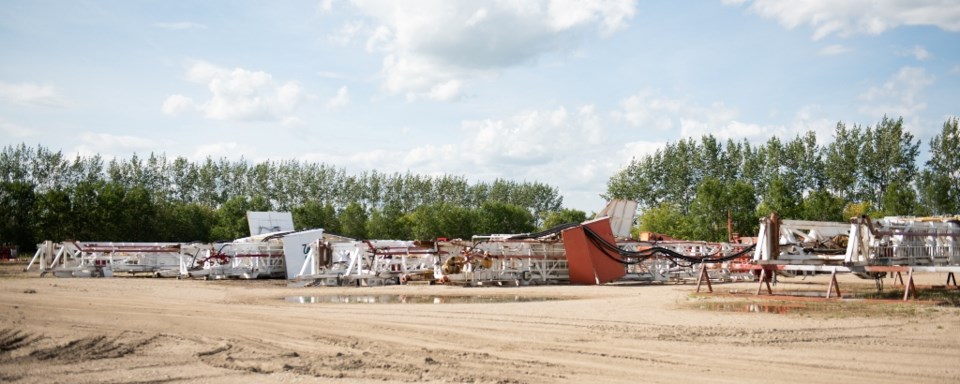Carlyle – Derrick Big Eagle couldn’t go see what was left of the drilling rigs he had built, as several were scrapped in recent weeks in the former Eagle Drilling Services yard in Carlyle.
Some of the eight former Eagle rigs were among the 10 Saskatchewan-based rigs Ensign Energy recently scrapped. Those yellow rigs sat, along with several orange former Totem Drilling rigs, in the Carlyle yard for the last five years, unmoving, as the oil downturn that took hold in late 2014 dramatically curtailed drilling demand.
Five were cut up and hauled away from the Carlyle yard. Another was cut up in place northwest of Stoughton, three more at Carnduff, and the final one in Waskada, Manitoba. Some of those were not originally Eagle or Totem rigs, but rather former Trinidad Drilling and Ensign rigs, as reflected by the paint schemes in the piles of chopped up scrap.
The first Eagle rigs were built in 2005, the eighth was completed in 2010, and the rigs that were cut up haven’t moved since 2015. That means that some of those rigs had just 5 to 10 years usage.
In December, 2018, Ensign Energy delisted 17 rigs from the Canadian Association of Oilwell Drilling Contractors (CAODC). In August and September, 10 rigs that had been based in Saskatchewan were torn apart for scrap. Daily Oil Bulletin reported at the time that 14 telescoping doubles were part of that 17 rigs, and the most recent one delisted was built in 2011.
Big Eagle, founder of Eagle Drilling, called it “heartbreaking,” on Sept. 15, saying, “I actually didn't even go watch it. It broke my heart so badly because I built those rigs that I thought that they were going to be 40-year rigs.
“I didn't even go look at the pile of scrap or nothing. Everybody’s saying to me, ‘Hey, they're cutting your rigs up over there, you know that?’ I heard about it, but it is what it is,” he said.
Eagle Drilling fired up in 2005, and by the time it sold to CanElson Drilling in 2010, there were eight brightly painted rigs. The office was adorned with aerial photos of several of them working in close proximity to each other during the height of the Bakken boom.
Asked what a life expectancy of a drilling rig would typically be, Big Eagle pointed to old Simmons rigs that were “as old as the hills” before they were finally retired and cut up. “They were older than I am,” he said, “and they were definitely not built to the quality that the Eagle rigs were built on.
“I put thicker walls on mine, thicker flooring, better quality metal, to make sure that they’d last. I wanted my goal to be that my grandkids’ kids would be able to look out in the field and say, ‘Hey, that’s one of Grandpa’s rigs.’
“I wanted them to last a long time, so we put a lot of extra effort into it.”
Ensign Energy did not respond to a request for comment. Regarding what Ensign’s possible motivation might be, Big Eagle said, “I guess that’s market share, and eliminating opportunities for anybody else to get into the market.”
“Nobody is going to get any money to build a $9 or $10 million drilling rig right now. Nobody's going to fund that. So everybody's going to be looking for the used stuff. And if the used stuff is all gone, then that means that there's no more competitors for them.”
With little used inventory available, it forces competitors to go to new equipment, nearly all of which will require raising significant funds. “And nobody’s going to give them any money,” Big Eagle said. “So, from a market share perspective of looking at Ensign and Precision, that was a right move. They eliminated the opportunity from any competitors. So in the long run, it's worth it for them.”
For Dennis Day, president of Fast Trucking Service, a Carnduff-based rig moving company, each rig cut up means a customer lost.
“It’s tough,” he said on Sept. 14, when asked about that.
Fast Trucking, in an effort to clean up its own yard, hauled out 1,039,000 pounds of scrap in July, alone, in addition to the work Ensign did in their yard. More scrapping has been done since. The iron Fast Trucking cut up was largely much older than what Ensign was cutting up. But Fast did actually buy six older jackknife rigs that Precision Drilling was going to chop up.
“Some of them will get cut up. Some I’ll keep. And will I ever sell them? I hope so, but probably not,” Day said. “It’s just a gamble, right?”
Asked for comment, the Ministry of Energy and Resources emailed the following statement on Sept. 15:
“Drilling rigs are depreciating capital assets with finite life spans. As drilling rigs age, technology and modernization may make rigs obsolete or render normal repairs and upkeep too costly to remain operate. A decision is then made on whether to upgrade/retire/store/sell the drilling unit. Normally, rigs that are current and are still capable of operating are not retired or scrapped.
“Unfortunately, in the current oil market environment, decisions to retire a drilling rig instead of spending the capital to upgrade, repair, or store the rig are made.
“The Government of Saskatchewan is optimistic that rebounding oil prices and demand will be key drivers in growing production and spurring investment in new drilling. The province is actively engaging with industry stakeholders on scoping potential new initiatives to help accelerate new investment and grow employment in the oil and gas sector as the industry continues to recover.”




